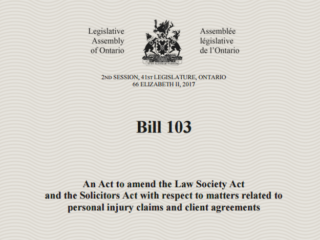Full Decision
A plaintiff must have knowledge beyond “mere suspicion” for a limitation period to commence, and in some cases, additional medical information is required for the plaintiff to have the requisite knowledge to discover his or her claim for an alleged medical complication.
Issue:
This summary judgement motion examined whether the plaintiff could rebut the presumption that his limitation period commenced the day that he received an allegedly negligent lumbar puncture (that left him with severe headaches) by contending that his cause of action was not discoverable until either he realized that the headaches were not temporary, or was informed by a neurologist that they could be attributed to the punctures.
Facts / Context:
On October 17, 2012, the plaintiff, from Ontario, was visiting Regina on a business trip. He suffered a medical event in his hotel room and was found by hotel staff in an incoherent, confused, and hallucinogenic state. An ambulance was called and the plaintiff was admitted to the defendant hospital under the care of the defendant doctors. He underwent multiple testing procedures, including four lumbar punctures, for what was thought to be spinal meningitis. The test results were all normal, however, the plaintiff experienced a persistent headache after the tests and was prescribed a course of Acetaminophen and a laxative at discharge. The next day, the plaintiff’s headaches were too severe to fly back to Ontario, so his wife flew to Regina and they drove home together.
By November, the plaintiff’s headaches began to worsen after completing his course of prescribed medications. He halted operations at his construction business due to their severity and began to realize that his headaches may not go away on their own. He continued assuming the headaches were connected to the previous hallucination event and did not connect his symptoms to the lumbar puncture.
In mid-December, he vomited from the intense pain and attended to his local emergency room. He was assessed by a neurologist, who informed the plaintiff for the first time that he was most likely suffering from post-lumbar puncture headaches. A blood-patch was ordered to treat the suspected puncture injuries, which provided instant, but not permanent relief.
The plaintiff issued his claim on October 24, 2014 – two years and seven days after he received the lumbar punctures. The defendant doctors moved for summary judgement under Saskatchewan’s Limitations Act, arguing that the plaintiff’s two-year limitation period had expired.
Defendant / Moving Party’s Position:
The defendants argued that the plaintiff possessed the requisite amount of knowledge to base his claim by October 17, 2012 – the date of the lumbar puncture procedure. They pointed to the plaintiff’s decision to drive home (instead of fly) as evidence that his injury was severe and he ought to have known that a medical complication had arose. They relied on ss. 5-6 of Saskatchewan’s Limitations Act, which outlined that a plaintiff is presumed to discover their claim on the day of the act or omission took place.
Plaintiff / Responding Party’s Position:
The plaintiff argued that the defendants’ negligence was not discoverable until either sometime in November, 2012 when he realized that his headaches were not temporary, or in December, 2012, when he was told by a neurologist that he could be experiencing post-lumbar puncture headaches. He argued that he required additional medical information to connect his symptoms to the alleged negligent act, and that this delayed comprehension of his medical condition rebutted the presumption that his claim was discoverable at the time that the puncture occurred. He further contested that he had undergone many other tests on the day that his headache emerged, and had also experienced a worrisome medical event just hours before its onset, and that these facts blurred a connection between the lumbar puncture and his headaches.
Analysis and Holding:
The plaintiff successfully rebutted the presumption that his claim was discovered on the day of the negligent act. The court reasoned that the plaintiff was not suspicious that he had experienced a medical complication on the day of the puncture, and that the earliest possible timeframe discovering that his headaches could be attributed to a medical complication was in November, 2012, when he realized that the headaches were not resolving despite the completion of his prescribed medications. The court articulated that a more reasonable timeframe for him to have discovered his claim was in December, 2012, when he was first informed by a neurologist that long-lasting headaches like his could be the result of lumbar punctures. As such, the court held that the claim was not discoverable until November, 2012 at the earliest, making its issuance in October, 2014 within the two-year period. The defendants’ summary judgement motion was dismissed, and costs were awarded to the plaintiff.














